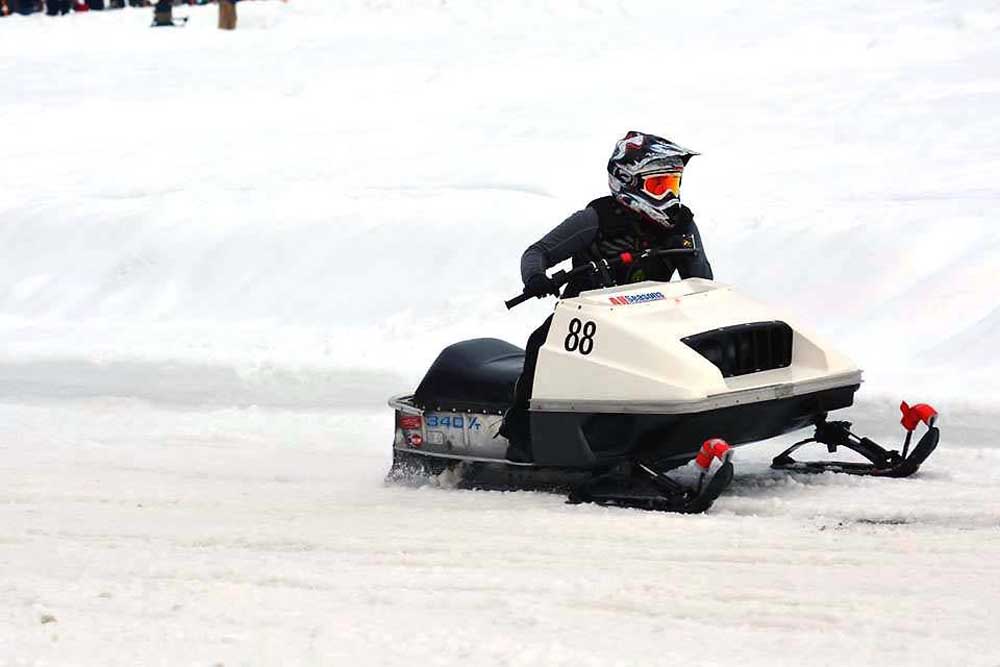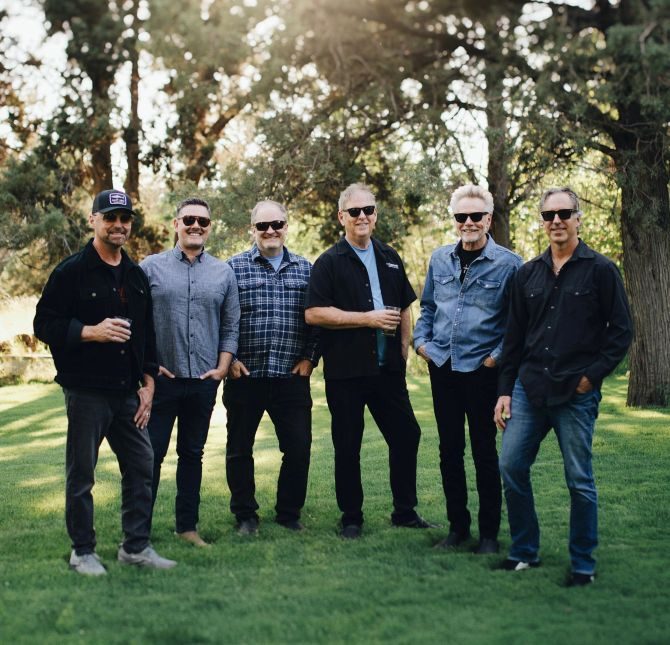Snowmobiling in Central Oregon
Published 12:00 am Saturday, January 19, 2019

- Snowmobiling in Central Oregon
Compared to today’s sleek, modern machines, early snowmobiles looked more like preposterous miscalculations of engineering than vehicles used to navigate snow and ice. Those original contraptions were ungodly, uncomfortable, and barely controllable. Imagine a piece of industrial machinery falling from a 10-story building and landing atop a passing skier—that’s a 1960s snowmobile. Thankfully, technology has advanced, allowing us to satisfy our desire to travel farther and more efficiently into harsh winter conditions on the optimized, aggressive machines we have now. A top-of-the-line snowmobile can cost as much as a small car and is stocked with luxuries such as hand warmers, state-of-the-art suspension, and incredible horsepower—a far cry from the first iterations of above-snow travel on motorized toboggans.
What was once a vehicle designed for basic snow travel has found a place in professional sports. Snowmobiling is now televised on ESPN and included in the Winter X-Games. But despite that, the versatile piece of equipment is more commonly used for winter navigation, search and rescue, trail maintenance, and other backcountry activities.
“The sport has changed so drastically over the years—the sleds are so much different,” said Kristi DeMoisy, treasurer of Moon Country Snowbusters. “The awareness has also changed, as far as avalanche dangers, what gear we need to help keep ourselves safe, but also what to have with us if we need to stay the night in the woods.”
Moon Country Snowbusters is a nonprofit snowmobile club, responsible for grooming over 250 miles of trails in the Deschutes National Forest. Organizations such as the Snowbusters are a part of a larger network, the Oregon State Snowmobile Association, which includes a number of clubs, individuals, and businesses within the industry.
Encountering a snowmobiler in the wild might be intimidating to an unfamiliar trail sharer. The gas-powered vehicles are constructed with a pair of front skis and a rear track that closely resembles the underside of a military tank. Top snowmobile speeds vary from 70 to over 150 miles per hour, and like any piece of heavy equipment, they require some degree of education and caution. Fortunately, organizations such as Moon Country Snowbusters exist to advocate for winter motorized recreation for the public.
When asked about how people get introduced to the sport of snowmobiling, DeMoisy said, “I think almost everyone gets into the sport because they have a friend who invites them along for one simple ride . . . and you are hooked.”
A key point that DeMoisy makes is that people should not simply rent the machines and zoom off beyond their comfort zone into potentially dangerous territory but become familiar with the activity with the help of the growing snowmobile community.
Central Oregon Adventures is a company based in Bend that offers clinics, excursions, equipment, tours, and general education for any level rider. Owner Amber Greiner has witnessed significant growth in the popularity of snowmobiling in her 15 years of experience in the industry, and she also stresses the need for basic skills and awareness when heading into the backcountry.
“On our guided trips, we have a riders’ safety lecture that covers machine operation, specific to the machines we use. Then we go through maneuverability, riding techniques, trail safety, and trail etiquette,” said Greiner.
Central Oregon Adventures operates out of Wanoga Sno-Park and uses a network of trails in the territory around Mount Bachelor. These trails, like most, are shared by a number of outdoor enthusiasts, including snowshoers, cross-country skiers, snowboarders, snowbikers, and even dog sleds. With the high probability of encountering other users, it’s imperative that snowmobilers understand two-way trail systems, hand signals, and general etiquette to give everyone the space and peace of mind to enjoy the outdoors during the winter months.
When it comes to these interactions on trails, Greiner compares snowmobiles to cars on the road, highlighting the need to give others the right of way. She credits rider awareness, respect, and courtesy as means of reducing conflict in the backcountry.
Due to enthusiasts, organizations, and clubs all working for the greater good, the sport of snowmobiling has made great strides in its evolution. A surprising fact about the history of motorized snow travel is that it didn’t begin until after the Wright Brothers’ first flight in 1903. According to Smithsonian Insider, it wasn’t until 1906 that Virgil White began “converting automobiles into snowmobiles by replacing the front tires with skis and the rear tires with caterpillar treads.”
In the 1920s, White began selling kits to transform the Ford Model T into a snow-capable vehicle. Compare that lumbering 1920s artifact to 2017 when extreme athlete Daniel Bodin displayed spectacular talent by landing the first double backflip on a snowmobile.
To say that the sport has grown is a massive understatement. Snowmobiling has been groomed, tinkered with, and pushed forward by years of steady advancements and passion. Today, many outdoor trail systems, such as those in Deschutes National Forest, depend on snowmobiles for winter grooming and maintenance.
“I don’t think many people who recreate in our forest think about our land and land rights and the process of how we keep our land open for the public to use. I don’t think they think about how the trails get cleared or what happened to the dead trees that fell, where the snow shelters came from, and how the wood arrived in the shelter,” said DeMoisy.
The progress of snowmobiling has required abundant effort and has not always been free of conflict. Moon Country Snowbusters places most of their focus on the mission of keeping motorized public recreation alive on public lands. The organization also plays a great role in educating trail users on changing laws, weather, and trail conditions. The Snowbusters as well as many other clubs in the Oregon State Snowmobile Association, many of them volunteer organizations, have contributed constant and proactive efforts toward advocating, maintaining, and supporting the snowmobiling community.
It’s easy to overlook the day-to-day minutiae that keep snowmobiling alive and vibrant as an outdoor activity. It’s just as easy to fall into rival groups—skiers versus snowboarders, snowshoers versus snowmobilers. Sometimes it requires a step back and an open mind to realize that all outdoor enthusiasts share and care for the same resources, regardless of the season.
Greiner’s snowmobile guides do daily trail checks, clearing fallen trees and debris. Moon Country Snowbusters maintain hundreds of miles of trails during the winter months. Every day, considerate hikers, snowshoers, and skiers have the opportunity to volunteer and contribute, even if that means picking up a single piece of garbage. At the end of the day, the results of these actions benefit everyone.
The thrill of snowmobiling attracts people of all ages, genders, and backgrounds. In the winter months, there is no better piece of equipment for exploring the backcountry than the snow-mobile, and despite the fact that snowmobiles can be quite expensive to buy, there are an ever-growing number of opportunities, clinics, and tours from companies like Central Oregon Adventures that lower the barrier to entry. There has been a particular uptick in rides and groups catering to women interested in the sport. Accordingly, every year more and more gear and aftermarket equipment is marketed specifically toward women.
“Over the years it seems like more and more women are getting into the sport; there are some phenomenal women riders in the snowmobiling community. There is something to be said about a rider who is comfortable riding in the backcountry and going everywhere she wants to go on her snowmobile,” said DeMoisy.
With the heart of winter upon us, it’s a beautiful time to be alive in Central Oregon. Because of snowmobiles and those who are passionate about them, many of us can experience the outdoors in an exciting new way.
This adventurous world of exploration and recreation is available thanks to companies and organizations like Moon Country Snowbusters and Central Oregon Adventures. At the very least, the thought of pushing through fresh powder, navigating otherwise inaccessible areas, and soaking in the stunning views will inspire a few more snowmobilers this winter. At most, it will remind all trail users, whatever their preferred method of travel, of the bountiful and beautiful luxury we enjoy in our public lands.








